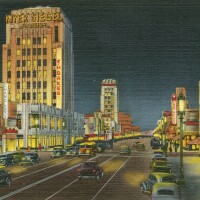The Grandeur of Bullock's Wilshire Tea Room

Growing up a rather particular child in North Carolina, from an early age I took great delight in novel experiences. So imagine my joy during the holiday season when my parents took me to the big department store in the Capital City, mainly so we could eat in the store's cafeteria, a mid-century, mahogany dining hall with delicious food and waiters who still wore bow ties (candy cane-striped for the Christmas season). It was a taste of a different time, when shopping at stores like Macy's or Bergdorf's was an all-day event.
I think my fastidious little heart would have exploded had I ever gone to Bullock's Wilshire Tea Room.
Bullock's Wilshire was the showpiece, the jewel in the crown, the "cathedral of commerce" of the Bullock's department store chain. Opened in 1929, this green copper-accented, art deco wonder was an innovative masterpiece, both inside and out. Built in the shape of a grand church, the store was the first to cater to automobile culture. Guests drove through a wrought iron gate into a painted porte-cochere, where valets whisked their cars away to be parked. One particularly eccentric customer, legendary entertainer Mae West, preferred to shop from her car, causing busy shop girls to run to and fro with big-busted dresses and long minks.


Once a lady or gentleman stepped into the store, they were greeted with an elegance and simplicity rarely seen on the West Coast. The layout was closed, with each department its own little boutique. Live models swayed around the Louis XIV salon in designer dresses, high rolling Hollywood players smoked cigars while being presented with shirts in Jo Bullock's wood-paneled private suite, and harried mothers could drop off their children in the crib-filled nursery before peeking into a room devoted solely to the creations of Coco Chanel, or indulging in a spritz of a new fragrance in the mirrored "Hall of Perfume."
On the fifth floor all these disparate shoppers met in the famous tea room. Decorated in soothing Southwestern tones of pale green, salmon, gray and blue, and accented with cactus-etched copper grating, the large tea room featured stunning views of the Hollywood Hills and a sleek Bauhaus-inspired design. Private dining rooms -- including the Salle Moderne with its lacquered paintings of desert animals -- a confectionery, and sitting areas radiated off the main room.
A Miss Larson oversaw the tea room, and made sure it lived up to the "Bullock's ideal" of excellence in service and presentation. The menu was light and refreshing, perfect for active shoppers and a welcome respite from heavy mid-century food. It featured such tea-time fare as finger sandwiches, pecan rolls, an assortment of fresh bread, including orange, date and nut, and cheese, and its famous Cantonese chicken salad with strawberry dressing. For dessert, fluffy coconut cream pie was a specialty, as was French chocolate layer cake, and a cream cheese ring with assorted fruit.
For the numerous figure-conscious Hollywood stars who frequented the tea room, including Gloria Swanson, Norma Shearer, Clarke Gable, Carole Lombard and John Wayne, there was also a "streamline menu." A veggie platter consisted of grilled tomatoes, mushrooms, string beans, asparagus, squash and celery. On Tuesdays, for only $1.25, there was a fashion luncheon where ladies could nibble all these healthful goodies while viewing models wearing the latest fashions.

Bullock's grandeur slowly faded with the decline of its Wilshire neighborhood and the emergence of competing stores. Maitre d' Humberto Lara kept the spirit of service and grace alive in the tea room for the older society ladies who continued to lunch here even as the food (which one '90s visitor called "unseasoned, tasteless and meager") served and the etiquette observed went out of fashion. The store was badly damaged during the 1992 riots and finally closed in 1993, taking it with it a whole style of commerce and community.
Unlike many of these L.A. stories of faded glamour, Bullock's Wilshire has had a surprisingly satisfying second act. It was bought by Southwestern Law School, which has been careful and diligent in its preservation efforts. The tea room is now used as a study hall, can be rented for private events and is opened to the public on the school's annual tea and tour day, which takes place during summer break. And the famed coconut cream pie still exists -- and we have the recipe here.
Top Image: Bullocks Wilshire/Antoine Taveneaux/Creative Commons Attribution-Share Alike 3.0 Unported license.



